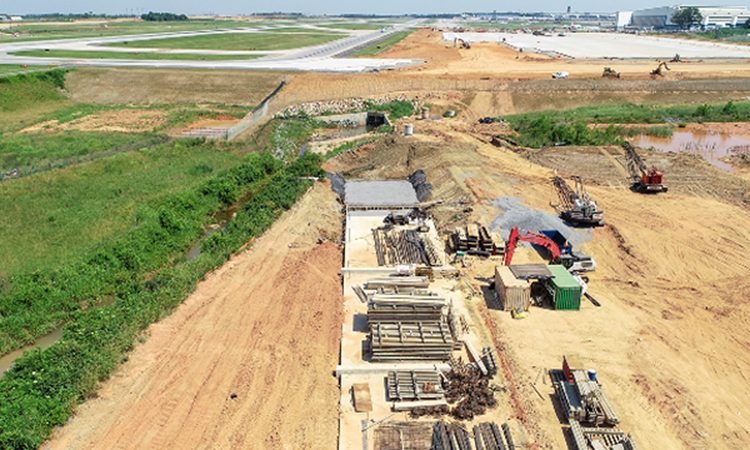FAA allocates $290 million for Charlotte Douglas International Airport’s fourth runway
Posted: 26 September 2024 | International Airport Review | No comments yet
The FAA has committed $290 million to Charlotte Douglas International Airport for the construction of a fourth runway, aimed at reducing delays and enhancing safety and capacity by Autumn 2027.


Credit: Federal Aviation Administration
The Federal Aviation Administration (FAA) has announced that it has committed $290 million in funding through the Airport Improvement Program (AIP) to support the construction of a fourth runway at Charlotte Douglas International Airport (CLT). Ground-breaking for this project took place in June 2023, with an expected completion date in Autumn 2027.
“[We] are committed to ensuring the safest and most stress-free experience for travellers possible,” said FAA Associate Administrator for Airports, Shannetta R. Griffin, P.E. “This fourth runway delivers on both – not only for travellers in and out of Charlotte, but for those flying from the nearly 200 cities with routes to CLT.”
In addition to the new runway, the funding will contribute to the development of north and south end-around taxiways and other airfield improvements aimed at increasing safety and capacity at the airport. Haley Gentry, CEO of CLT, said: “The funding will enable the airport to continue progress on this crucial and nationally significant infrastructure project, boosting capacity and operational efficiency.”
Join us live: Shaping the Next Generation of Hold Baggage and Air Cargo Screening
Join us live for an insightful webinar on 11th December at 14:00 GMT, in collaboration with Smiths Detection, as we explore the strategic balance of operational efficiency, regulatory compliance, and sustainability in high-volume security environments.
This session offers a focused look into future-proofing your security strategy.
Key learning points
- Cost Reduction: Strategies to minimize bag travel time while simultaneously reducing operational costs.
- Regulatory Roadmap: Insights into the next wave of regulatory changes and their impact on future investment decisions.
- Sustainable Systems: Practical approaches to building sustainability into security systems and lowering the total cost of ownership (TCO).
- Scalable Solutions: Real-world examples of scalable systems supporting current airport growth and preparing for tomorrow.
Register now for expert insights, case studies, and actionable strategies on operational efficiency!
Project benefits
The new runway is expected to have several key benefits:
- Reduced delays at CLT: A benefit-cost analysis by the city projects that without the fourth runway, average aircraft delays could rise by 58% over the next 15 years, equating to an additional 12 minutes of waiting time for flights
- Reduced system-wide delays: As a major connecting hub, CLT serves a significant number of passengers transferring between flights. The addition of the new runway is anticipated to minimise delays that could ripple through the broader air traffic system
- Improved safety: The project will also enhance safety by addressing a recognised taxiway “hot spot,” which is an area identified as having a higher risk of collisions or runway incursions. Standardising the geometry of the airfield will further mitigate these risks.
Funding structure
The FAA’s funding commitment is part of a Letter of Intent (LOI), designed to support large-scale capacity projects through a multi-year funding schedule. This approach offers airports greater predictability compared to the annual process of entitlement and discretionary grants. The disbursement of funds will begin in Fiscal Year 2025 and continue until Fiscal Year 2034.
As the construction progresses, the fourth runway is expected to play a crucial role in boosting CLT’s capacity and operational efficiency, ultimately contributing to a more effective air travel network for the region and beyond.
WATCH NOW ON DEMAND: Enabling checkpoint flexibility with responsible open architecture
Join us for an essential virtual panel supported by Smiths Detection. We will explore how airports can overcome the challenge of mixed vendor systems by adopting a flexible, open approach to checkpoint technology.
This session offers a focused look into achieving efficiency, agility, and future-readiness.
Key learning points
- Understand what to ask during procurement to ensure long-term flexibility and avoid vendor lock-in.
- Learn how centralised image review and flexible algorithm use can help you get more from the technology you already own.
- Strategies to make mixed vendor screening systems work together to improve checkpoint performance and reduce costs.
- See examples of collaborative deployments and the operational agility they enabled.
Register now for expert insights from Los Angeles World Airports, Dutch Ministry of Justice and Security, and Smiths Detection!

















